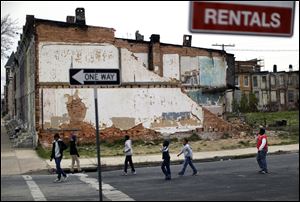
Editorials
Stuck in neutral
Whatever Ohio and the rest of the country have done to fuel an economic recovery and alleviate poverty hasn’t worked
9/22/2013
The national poverty rate held steady in 2012 at 15 percent, the Census Bureau reported last week. In this April 4 file photo, children walk past a partially collapsed row house in Baltimore.
Ron Haskins of the Brookings Institution best summed up the slew of Census Bureau statistics on the economy that dribbled out last week: “Everything’s on hold, but at a bad level.”
The numbers reflect a stagnant economy that, while no longer in a free-fall, continues to register widening income gaps and lock millions of people into poverty and hopelessness.
Click here to read more editorials.
Whatever Ohio and the rest of the country have done to fuel an economic recovery and reduce poverty has not worked, especially to alleviate the plight of low-income children. More than 1.8 million Ohioans lived in poverty in 2012, including nearly one of four children, and half of the state’s African-American children.
Unless the state and nation are prepared to tolerate unacceptable rates of poverty and growth, the latest Census Bureau reports should be a call for new social and economic strategies.
Nationwide, the good news is that, for the first time in a half decade, household incomes didn’t drop and poverty didn’t rise. The U.S. economy has expanded since the recession ended in 2009, but income gains have occurred almost entirely at the top. Any growth failed to lift most incomes and left more than 46 million Americans in poverty.
The national poverty rate held steady at 15 percent — 2.5 percentage points higher than it was before the economic downturn. Adjusted for inflation, median household income also remained just above $51,000 last year, down 9 percent from more than $56,000 in 1999. During that same period, the real economy grew 28 percent. Income is down 8.3 percent since 2007, when the economy started to tank.
In Ohio, the poverty rate stayed at just above 16 percent last year. Median household income last year — under $47,000 — represents an 11 percent drop over the past dozen years.
Even more troubling, Ohio’s child poverty rate remained at roughly 24 percent, compared to 18.5 percent in 2007, a 28 percent increase. Last year, slightly more than half of Ohio’s African-American children were poor, one of the nation’s highest rates.
Given those figures, it’s appalling that the U.S. House proposes to cut food stamps by $40 billion over 10 years.
Local trends were similar in the Census Bureau annual American Community Survey for 2012. They showed a flat poverty rate of 14.5 percent, considerably higher than 11.2 percent in 2009, and a slight increase in the Toledo-area median household income. It edged up 1.4 percent to $43,334 last year. That’s still significantly below the median of $47,700 in 2008.
Moreover, local social service officials say people returning to work last year often took part-time jobs without benefits.
“We’re not seeing the kind of post-recovery gains the state needs,’’ Hannah Halbert of Policy Matters Ohio, told The Blade editorial page. “We have too many people in poverty, and way too many kids in poverty.”
Poverty is a multidimensional problem, involving, among other things, transportation, education, health care, job training, affordable housing, and financial literacy.
Cities such as Toledo must have collaborative plans to coordinate local resources to get poor people training, transportation, and jobs. They must push local public and private agencies to cooperate instead of work in silos.
The federal government and state governments also need new strategies for economic development. For too long, Ohio has pushed an almost singular agenda of tax cuts and austerity — policies that assume, wrongly, that low taxes are the main drivers for economic development and job growth.
Employers consider many issues in deciding where to locate or expand, including work-force quality, schools, cultural amenities, public safety, roads and other infrastructure, and mass transit.
Creating good-paying jobs, bolstering the safety net, and lifting people out of poverty through training and education will take new thinking and new policies. As the latest Census Bureau figures make clear, the old ones aren’t working.